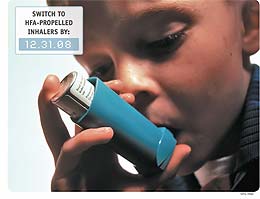
|
Summer 2008
The Clock Is Ticking
Improve Asthma Control by Knowing Your Triggers
Lung Health Tips
All Nebulizer Medications are NOT Created Equally
News Bits
« Back

LungHealthOnline
|

|

|

The Clock Is Ticking
 With only six months to go until the total phase-out of CFC propellants for albuterol inhalers, the Food and Drug Administration (FDA) notes that more than half of all inhaler users have still not transitioned to HFA medications. “It’s time to act and make sure everyone is aware of the changes that will occur,” says Tom Kallstrom, RRT, AE-C, FAARC, chief operating officer of the American Association for Respiratory Care and a certified asthma educator. With only six months to go until the total phase-out of CFC propellants for albuterol inhalers, the Food and Drug Administration (FDA) notes that more than half of all inhaler users have still not transitioned to HFA medications. “It’s time to act and make sure everyone is aware of the changes that will occur,” says Tom Kallstrom, RRT, AE-C, FAARC, chief operating officer of the American Association for Respiratory Care and a certified asthma educator.
There are several things that respiratory care patients should be aware of as the deadline for total phase-out of CFC-propelled inhalers hits on Jan. 1, 2009. “If you use an inhaler, it’s important for you to understand the differences between CFC- and HFA-propelled inhalers,” says Kallstrom, who offers the following information about switching to an HFA inhaler:
- Talk with your physician as soon as possible to be sure you are taking aerosol medications that will be available after December 31, 2008.
- The HFA-propelled inhalers do not contain or use surfactants for dispersion but instead use alcohol for this purpose. Using an HFA can help you overcome some of the problems you may be having with CFC-propelled inhalers, such as priming, temperature effects, tail-off, and plume geometry. HFAs are effective and safe.
- The experience of using an HFA-powered inhaler will be a little different. The sensation of the aerosol plume will be warmer and the volume will be less, so it will feel softer than the CFC-propelled inhaler. It needs cleaning to prevent build-up, and it must be shaken with each use and primed. You will be getting the same medication. It’s working the same way; it just feels different.
- You can go to this U.S. government web site to learn more about switching from a CFC-propelled inhaler to an HFA-propelled inhaler.
Your doctor and respiratory therapist are the most qualified people to answer any questions you have about your inhalers. Don’t wait; ask now so you can be prepared for this change, because on January 1, 2009, you will no longer have access to CFC-propelled inhalers.
| Differences in Characteristics between CFC and HFA MDIs |
| Physical Component Delivery of Dose |
CFC |
HFA |
| From a near-empty canister |
Variable |
Consistent |
| With variable ambient temperature |
Variable |
Consistent (to -20° C) |
| Spray |
|
Any |
| Force |
Higher Impaction |
Lower (3 times) |
| Temperature |
Colder |
Warmer (approx. 30° C) |
| Volume |
Higher |
Lower |
| Taste |
Different from HFA |
Different from CFC |
| Breath-hold |
Less important with CFC |
More important with HFA |
| Priming |
Important following short period of nonuse |
Longer time of nonuse allowed without priming |


|

|


 With only six months to go until the total phase-out of CFC propellants for albuterol inhalers, the Food and Drug Administration (FDA) notes that more than half of all inhaler users have still not transitioned to HFA medications. “It’s time to act and make sure everyone is aware of the changes that will occur,” says Tom Kallstrom, RRT, AE-C, FAARC, chief operating officer of the American Association for Respiratory Care and a certified asthma educator.
With only six months to go until the total phase-out of CFC propellants for albuterol inhalers, the Food and Drug Administration (FDA) notes that more than half of all inhaler users have still not transitioned to HFA medications. “It’s time to act and make sure everyone is aware of the changes that will occur,” says Tom Kallstrom, RRT, AE-C, FAARC, chief operating officer of the American Association for Respiratory Care and a certified asthma educator.